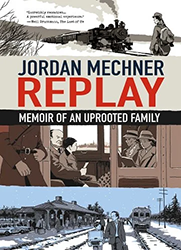Several pages into Miriam Katin’s graphic memoir, Letting It Go, we see four symmetrical and beautifully rendered colored-pencil drawings of the George Washington Bridge looming over the Hudson River. The seascape shifts image by image, and the words carefully sketched out at the top of each panel reveal a slow entry into the complicated and difficult task of the very artistic project we are holding in our hands: “So, where does a story begin?” the narrator asks at the top of the first panel.
Katin’s second memoir is a kind of corollary to her first, successful book, We Are On Our Own, a graphic memoir that recounted the story of how she and her mother escaped the Nazi invasion of Budapest. In her earlier, more conventionally-styled book, Katin relates a broken childhood, and the story ends with a girl steeped in a deep cynicism and distrust of the world around her. In the final image of We Are On Our Own, a young Miriam, wearing a short-sleeved, girly dress and bows in her hair, plunges a fork into a toy soldier as she questions the existence of God.
Published seven years later, Letting It Go picks up with the story of a middle-aged Miriam Katin, who lives with her husband in an apartment in Washington Heights and grapples, among other things, with writer’s/artist’s block and a cockroach invasion. These details – the ins-and-outs of New York City life as an artist – serve as thoughtful digressions to the primary focus of the story: Miriam’s inability to accept her adult son’s decision to move to Berlin, a city that represents her dark past. In Letting It Go, Katin interweaves her telling of these everyday disturbances alongside her grappling with the memories that haunt her, revealing how that past lives on in the present. This book-long meditation, presented in visually-stylized fragments, exposes the narrator’s emotional states as she journeys through the process of confronting, reliving, and at some points even releasing her ties to that past.



